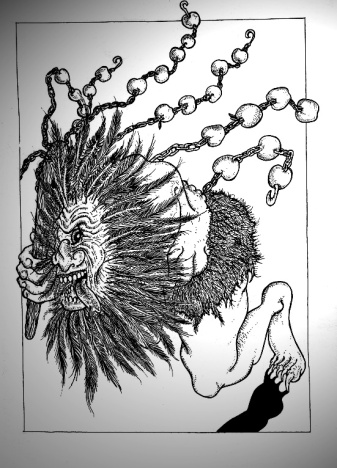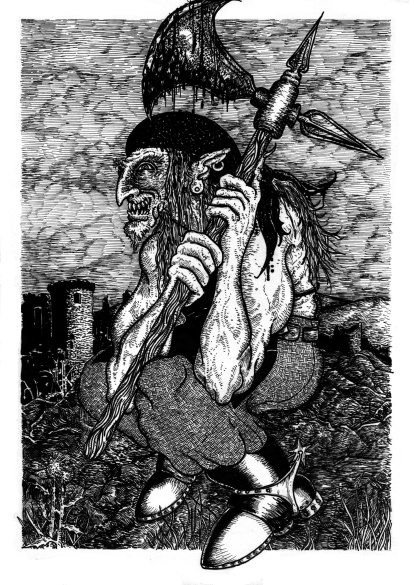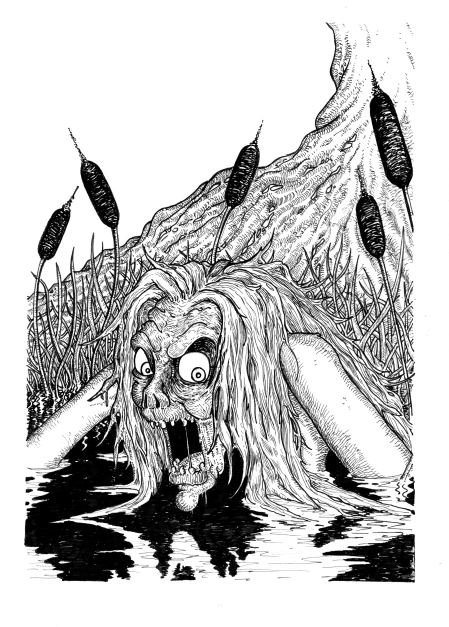By Andy Paciorek, author and illustrator of Strange Lands: A Field Guide to the Celtic Otherworld & Black Earth: A Field Guide to the Slavic Otherworld.
Foreword
The fairy doors within the Between Worlds exhibition were home to numerous types of fairies to discover: Banshees, Selkies, Hobglobins, and Brownies. However, these are not the only fairies in the North. In this post, author Andy Paciorek discusses – both through stories and his own illustrations – the darkest fairy folk of Northern Britain.
Jade Westerman, Exhibitions Assistant at Palace Green Library
“We should naturally attribute a less malicious disposition, and a less frightful appearance, to the fays who glide by moonlight through the oaks of Windsor, than to those who haunt the solitary heaths and lofty mountains of the north.”
Sir Walter Scott
Should we? Is it the case that, when it comes to Otherworldly denizens, it is indeed grim (or Grimm) up North?
It is a matter of course when dealing with the Hidden People that care must be taken, for all are capricious; they may appear genteel and kindly, but like a golden coin made in payment by such folk, their manner could change as dramatically as the precious metal turns to a dry and dusty dead leaf. Their very nature is in question – what are they? Some theories suggest that the faeries are fallen Angels or alternatively the spirits of the deceased. If the latter, then any necromancer will tell you that you cannot trust the dead; if the former, well they are not even trusted by God. If they are neither of these but are indeed a curious species unto themselves, then in all circumstances their ways differ to those of most humans. Strange and dangerous encounters with the (not always so) Good Folk have been recorded across the British and Celtic isles. The more I dwell upon Scott’s comment, more malevolent entities of the North creep into my mind like insidious earwigs.
To the Scots, there was a clear distinction between the natures of the not so bad and the not at all good faeries. The benign belonged to the Seelie Court – the blessed, the joyful. The others – the malevolent, the blighted, the demonic ones – were the Unseelie Court. Also known, in hushed tones, in various places by myriad other names, such as the Host, the Spirit Multitude, the Sounds of Infinity – the Unseelie Court manifested first as an ominous, brooding, black cloud sweeping across the darkened, crepuscular northern skies.

© Andy Paciorek
As the sinister horde approached, writhing among their number were a multitude of the vilest Fay beings imaginable, hollering and snarling hexes and curses. Also, perhaps to be spotted amongst their number, were the lost souls of the deceased who had passed over from their wicked lives.
Soaring through the air, the vicious maelstrom of the Unseelie Court would damage crops and dwellings and inflict injury upon both man and beast with a flurry of elf-shot (people who found Neolithic flint arrowheads would in the past sometimes identify these as the weaponry of fairie forces). Other unfortunate folk could find themselves snatched into the air by the grasping fingers of the Multitude. They may become roughly compelled to join the Court in their unholy practises or simply dragged along for a nightmare ride before being unceremoniously dumped many miles away from where they had been abducted. Some victims would be found alive; others less so.

© Andy Paciorek
To avoid such an experience, should one see the Faerie Host approaching through the air, then some of the following words might protect from injury or death – to exclaim “God Bless you” at the gathering storm. To hurl your left shoe at the Unseelie Court or to wear a sprig of Rowan. These tokens might protect, but we stress the word might.
However, not all of the malevolent fays and otherworldly entities of the North Country were gregarious. Others were solitary, but no less savage.
Briefly, I will outline merely some of these strange and sinister beings.
Armed with a wooden flail tipped with poison apples, the Fachan is a one-legged, one-eyed, one-armed fiend of the hills of Western Highlands and Argyllshire. Plumed at the neck with an array of blue feathers and clothed only in rough fur scraps, oddly the Fachan has been considered by some to be a folk-memory of the Celtic seers of olden times, who, with one arm outstretched, one eye closed and standing on one leg, would in such a manner commune with the Otherworld.
Along the English-Scottish borderlands, particularly in the locality of old forts and castles and their ruins, lurk the Red or Bloody Caps. Named after their headwear, which is dyed in the blood of their victims, these fiends, armed with halberds or pikestaffs, wear cumbersome iron boots, which is curious as most fairie breeds intensely fear iron. Red Caps may sometimes serve as familiar spirits to sorcerers and warlocks versed in the blackest of magical arts.

© Andy Paciorek
Numerous rivers of the North are haunted by Groac’h or Water Witches. In the county of Durham and its neighbouring county where the River Tees flows, children playing on the water’s edge may fall foul of the green haired, sharp tooted water harridan Peg Powler. Seducing the children with brightly coloured trinkets placed on the bank side, she will grab them with her strong, sharp, spindly fingers and drag them beneath the surface to drown and sometimes to provide a feast of blood, bone and flesh to the hungry Water Witch. In the River Skerne, a tributary of the Tees in the Darlington area, dwells Nanny Powler, Peg’s equally nefarious sister.

© Andy Paciorek
Many more weird and wondrous entities and creatures can be found within the pages of Strange Lands: A Field Guide to the Celtic Otherworld and Black Earth: A Field Guide to the Slavic Otherworld, both written and illustrated by Andy Paciorek. More information can be found here and on Goodreads.
Andy Paciorek is an artist and writer drawn mainly to the worlds of myth, folklore, symbolism, the supernatural, decadence, curiosa, forteana, anomaly, dark romanticism and otherworldly experience.
His solo books, Strange Lands: A Field Guide to the Celtic Otherworld and The Human Chimaera: Sideshow Prodigies and Other Exceptional People are to be followed by Black Earth: A Field Guide to the Slavic Otherworld.
He has produced art work for numerous projects, such as Harper Collins’ Element Encyclopedia and Art for Mindfulness series, Cumbrian Cthulhu and has worked on books by several notable writers including Dr Bob Curran, John and Caitlin Matthews, Chris Lambert and Dr Karl Shuker.
He is the creator of Folk Horror Revival multimedia project and Wyrd Harvest Press, and you can find their Facebook and Twitter here.
Although Between Worlds: Folklore and Fairytales from Northern Britain is now closed, you can still view and contribute to our collection of favourite sayings, customs and folklore in the comments section. Visit Palace Green Library’s website for more information on our future exhibition programme: https://www.dur.ac.uk/palace.green/.

